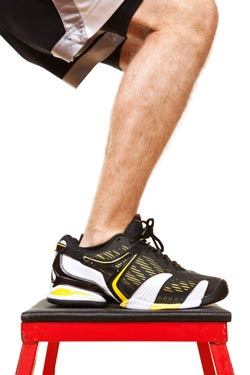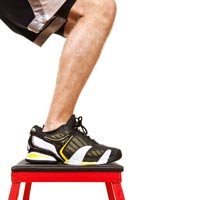
By Carl Valle
It’s not about Cueing or Magic Words
A lot of hype on motor skill acquisition is spreading online and being a proponent of athlete centered coaching, we need to step out of the limelight a bit and understand our roles. Plyometric exercises range from simple bouncing during a warm-up to an intense series of jumps and bounds during heavy training periods. With any risk from training, coaches need to ensure the right mechanics of the exercise is done properly and the right ways to teach the movement patterns. The simple question is what is right and what can we do to promote it properly? The answer is just as simple as the question, work backwards by seeing the best coaches and athletes and learn from them. Of course differences will present themselves, but many great coaches have similar mentors and have come up with the same conclusions if they are not from the same coaching tree. Conveniently the same rules and suggestions from the article on training plyometrics for speed help the actual teaching, since general principles of coaching are often useful for all areas of training, including instruction.
The Taxonomy of Plyometric Exercises
Going back to fundamentals and terminology is not exciting, but it’s the cornerstone to good program design and teaching. I have used very little plyometric exercises for sprinters and virtually none for hurdlers, but I do believe everyone should have some exposure to the jumping exercises for durability. What I have learned from coaching jumps, events that are not my expertise but do benefit the aid of a sprint coach is that use plyometrics purposely, as event training does have a role in building elastic capacity. To get on the same page, here are the core plyometrics that most use to develop athletes.
Throw
|
Hop
|
Jump
|
Bound
|
Skip
|
|
Takeoff
|
One or Two Feet
|
One Foot
|
Two Feet
|
One Foot
|
One Foot
|
Landing
|
One or Two Feet
|
Same Foot
|
Two Feet
|
Other Foot
|
Same Foot to Opposite
|
Loads
|
Implement
|
Internal
|
External
|
Internal
|
External
|
Purpose
|
Total Body
|
Stiffness
|
Power
|
Specific Power
|
Skill
|
Force Direction
|
Various
|
Various
|
Vertical
|
Horizontal
|
Various
|
To help explain the grid shown above, each modality classification is listed on the top of the column and the rows show specific attributes and execution properties. Again most of the information here is for lower body plyometrics as upper body is more for throwing and combat sports, but some general concepts may help.

Takeoff — The first row denotes how the athlete takes off, either from one foot or two. Taking off with one or two feet may not be a clear indicator of output since many single leg actions with run ups may have a lot of forces such as bounding after a fast acceleration and jumping with two feet is limited because nature made us bipedal with alternating legs and not kangaroos.

Landing — Landing is arguably the primary variable that classifies the plyometric activity. Hops differ from bounds because they stay on the same foot from take off to landing, and bounding requires an alternation of each leg and can be only one on foot at a time. Jumping is a little cloudy, as two of the four jumping events in track and field take off on one foot and don’t really land on two, but both feet are forward ready in the pit. Skipping is a little more of combination movement and not perfectly symmetrical but it does have a double contact.

Loads — The third row includes commonly applied loads, meaning do coaches usually add a hyper-gravity load such as a weight vest. Most use weighted vests because coordinating arms with the plyometrics is paramount, and that is why most of the best coaches prefer sprinting with light sleds versus pushing heavy sleds. Throws are obvious, since an implement, usually a medicine ball is an external load that forces the athlete to create a summation of forces to propel out. Since the single leg demands of bounding and hoping are high, most coaches don’t add loads but like anything, exceptions to the rule are possible.

Purpose — The fourth row is the main purpose or primary quality we are trying to improve with each plyometric modality. One word can’t possible summarize all the benefits of one exercise, but it’s a good idea to try to see the root goal of each movement. Throws are requiring more trunk and upper body demand are excellent tools to help teach Olympic lifts without spending too much time with broomsticks and unloaded exercises and are great ways to help warm-up safely during stale periods. Hops are often rudimentary work to help with preparing for greater forces and are perfect tools to prepare the lower leg. Jumps being two legged allow coaches to exploit bilateral facilitation, something that many single leg proponents need to read up on. Bounding is very specific to horizontal jumps and perhaps are the closest to running, and Master Coach Randy Huntington suggests speed bounding with two different techniques. One style is a hip emphasis (thigh up and thigh down) and the other is a reduction of range of motion creating another unique adaptation. Finally skipping is great for coordination and general preparation of the body for athlete health.

Force Direction — Horizontal and Vertical forces have been buzz concepts online and any plyometric activity can be done either up and down or going forward/back. The chart many not do justice to the options, but if you look at the most commonly prescribed methods and summarize the forces involved, most of them will fit in the categories above. Also force plates are only one part of the equation, since a back throw may not be generated just from horizontal forces because the paraspinals are used and the feet may be on a toe board. When looking at jumps, specifically those used in testing such as the Bosco tests, vertical emphasis is the prime target.
All of the above are suggestions and some are more rigid than others, but the goal is to see what the intent and differences are between the exercises first so we can better instruct the exercises. As mentioned in the benefits of the throws being indirect teachers of more complicated exercises later, that is perhaps the heart and soul of the article. Learning is about the athlete acquiring skills by doing, not about the coach talking and being the focal point. It feels good to be knowledgeable and verbally commanding, but at the end of the day athletes are going to reactionary to what you have done in the past rather than athletic puppets dependent on coaches magic words.
How to Guide Athletes to Performing Tasks Properly
When I visit the best coaches I see a lot of similarities with each coach having a unique style and a specific flair for different areas of instruction or teaching. When coaches are focused on their self-importance, the ratio of talking and standing becomes exponentially higher with the ineptness of their abilities. The master coaches are guides and hint on refining the movements by subtle suggestions because they know the right recipe, the charlatans seem to be very focus on what ways they are involved with training directly.
What I have learned the hard way is that athletes need to be given the right tasks or challenges and explain the outcomes. Live demonstrations help, but many of the exercises with plyometrics are natural movements are reflex dominant, making them more about setting up the right responses over consciously producing the right outcomes.
The right execution is not about joint angles or muscles yet, since many of those details fall into place if you set up the training elements first. Within each type of plyometric exercise is an execution style or option, and the chart below we will focus on the purpose of the style and rationale behind each option. The left side of the chart in red is a summary of the contraction style of the exercise and the blue is the landing style used.
Elastic
|
Isometric
|
Control
|
Soft
|
Buoyant
|
Stick
|
Very Common
|
Rare
|
Rare
|
Common
|
Common
|
Common
|
Various
|
External Load
|
External Load
|
Various
|
Various
|
Various
|
Very Heavy
|
Extreme
|
Heavy
|
Very Low
|
Low
|
Moderate
|
Speed and Jumping
|
Catalyst
|
Starting Power
|
Landing
|
Internal
|
External
|
The loading characteristics with the third and fourth row are purposely grayed out, as this article is more about teaching than training. What I will do is share the landing styles and how the match the contraction options and connect them to the underlying purpose of what coaches are driving at.

Landing Styles
When most coaches think plyometrics they think about reactive or elastic responses to ground contact, not slowing down the landing. What sounds counterproductive at first is the best starting point of plyometrics; learning how to land properly. Eventually one has land or stop, so it’s good to start with the end. Yet if one asks an athlete to stop, the word will conjure up different images to different athletes, and you will see different interpretations of the instructions. This is why cue words and verbal instruction is not perfect and we must share the goal or outcome we want first, rather than try to last minute dump a suggestion of how to do a task. When an athlete knows the goal of the exercise or task, they are empowered. When the coach is trying to lead the athlete with their own words and instructions, the athlete is crippled because they are blinded by the limits of the coach. Ironically motor skills are about the brain, yet coaches like cutting off the connection and hope that the ears are able to problem solve the task at hand. So when we talk about landing, we need to differentiate between landing slowly to a stop, meaning decreasing or triple flexion with a soft landing. The analogy of catching an egg is good here since you want to use as much distance and time to slowly dissipate forces. Buoyant is a rapid deceleration down and switch to rising tall again to a near starting point. The up and down motion of a buoyant landing is controlling elastic energy but not redirecting it to another jumping motion. While it’s not truly plyometric, energy should be used to come up but not enough to create projection. Finally we have the stick the landing style that we have seen in gymnastics. Basically it requires the athlete to freeze at the same position or joint angles that they land at and hold it briefly. We see this with shock like jumps from altitude boxes but it can be done with nearly any exercise to teach joint position and body awareness such as posture. All of the mentioned techniques of landing are great for preparing for redirecting energy in plyometrics and are not to be seen as beginner stuff. I have seen great athletes jump on a box that is 50 inches high and step off it slopping with plantar flexion over and over again, only to wonder why they are having tendon problems. Respecting the landing pays off as most are already thinking about the next jump and get sloppy.
Contraction Type — Most plyometrics should be done as rapid as possible but storage and release of elastic energy is not about simple contraction and relaxation, but about utilization. Pure up and down jump exercises and letting the reflexes of the body and good technique create the adaptations is the most common and arguably the whole point of plyometrics. At times this near spinal response will need a little cognitive input by the forebrain. The two additional options besides pure elastic are less common and mainly advanced, as using an isometric hold from an external resistance is great potentiation for some high level athletes and a safe way to overload the body if done right. The controlled version of plyometrics is a slight slowing down of momentum to guide the exercise more. We see this with jump squats and other weighted jumps that are utilizing elastic energy but are seen as strength exercises as well.
Throws and jump squats or anything with an external load must be done with care, since additional weight is brainless, meaning unlike myofibril hypertrophy of muscle that has a smart nervous system, external loads are just lead or other metal that has only one purpose and that is enhancing gravity. Gravity is force of nature that has no emotion and always wins, so combining high velocity exercises and weights should be done with techniques and methods that are safe. Ballistic activities are susceptible to fatigue, technique errors, and momentum that can hurt athletes if placed in without prerequisites. Doing the activities similar but without external loads (bodyweight with speed) or external loads without speed (strength exercises) first is a great progression. I am not a fan of step by step advancement of athletes because progressions usually shared by online resources are just opinions and one option, but sometimes a commonsense approach is effective.
Task Purpose and Goals
The last row has the reason behind each contraction type and each landing style. Clearly the near pure elastic response is great for jumping and sprinting, and that is likely to be the approach done by the majority of coaches. Isometric like components involved are not true plyometric contractions, but they are popular options to create additional motor unit recruitment with some athletes. The research is not 100% in agreement about the neurophysiology, but potentiation has enough research behind hit to merit the use. Controlled positions may have use for starting power as preloading the stretch of muscles may not be an elastic response, but active preloading is not a dead start as muscle activity is present even when still. Lack of motion doesn’t mean a lack of muscle usage, and like isometric contractions the role of partial elastic contractions do help with some sporting and training activities.
The landing roles do have physiological benefits, but most are to safely teach triple flexion in order to train and overload triple extension later. Absorbing energy should be a priority in the beginning of training with all athletes with all levels of abilities. Amazingly some athletes are talented enough to skip past fundamentals with no problem, but many athletes will get bit by the injury bug later because they are hiding compensations, because the movements are so fast, very few will notice.
From Year to Career — Long Term Plyometric Development
With teaching or instruction, the right curriculum that is outlined properly is the expressway to learning. It’s not how fast an athlete is taught, it’s how well an athlete retains information and how little roadblocks or “traffic jams” athletes have. It’s easy to think about day one of training in the moment, but good perspective is a healthy long term view of what to expect of an athlete. Starting with an entire career, we can see how slow progression appears to be at first glance, but if you are training consistently and injury free, the development is more steady and could be far faster. Below are the four general development phases of an athlete, from beginner to elite, with the clear explanations and milestones of what is expected with plyometrics. To distil each phase to the most important attributes I have looked at the common threads with great programs in both track and field and general strength and conditioning programs. I find that while track coaches are great silos of information, some strength coaches are just as sharp and their information is just as valuable.
Beginner
|
Intermediate
|
Advanced
|
Elite
|
Landing
|
Bouncing
|
Increasing
|
Optimizing
|
Teach safety and expose them to correct fundamentals
|
Train and learn to be a great jumping athlete
|
Learn to challenge intensity and necessary voluems
|
Ensure the sequence and loading is precise and specific
|
A super talented 13 year old who is winning everything is a beginner and should be treated just like the kid who is last in races. Mastery is about consistency not just proficiency. Just teaching landing for months is not the end of the world, since a good program will be doing a wide variety of activities. I have learned from watching some great coaches that munch of the advanced actions are fundamental movements without the visual label. For example a few soccer power kicks for distance or speed are explosive single leg plants without the pounding. Running throw ins, again from soccer, are great deceleration preparation activities that are good for trunk strength and learning power positions for intense bounding, provided the pelvis is blocking properly. This is why playing a lot of sports may harm or help youth athletes. Since playing multiple sports may expose athletes to a wide range of skills is good, usually what happens is that they compete all the time and do tournaments like an all you can eat buffet. Good specialized academies are paradoxically developing better athletes, since they control (read reduce) competition and focus on athlete development with preparation. Good preparation is general and usually cross-pollinates with other sports.
Intermediate athletes can start doing a wide range of jumping exercises, starting from in place jumps one rep at a time, then progressing to activities with equipment. I have seen and believe that most activities should not use equipment unit transitioning to advanced levels, since most of the equipment is about creating intensity such as boxes or hurdles. I also suggest making hurdles out of PVC pipe, since I have seen enough injuries from human error at all levels that makes me rethink how luck I have been. Sometimes a little fear can get some adrenaline, but if I had to do it over again I would build more hurdles form Home Depot.
When an athlete hits the advanced levels measurement and output become more important. Coaches are now expecting an athlete’s technique is refined enough that focusing on developing more power and speed. We tend to see requests for higher heights of throws, hurdles, boxes, and a desire to see the tape read longer in the horizontal jump tests. Soon coaches add external loads and hope to see all of this transfer to either running or the jumps themselves.
Finally we see with the elite a focus on getting to the runway or starting line healthy and tinkering with the subtle details. At the elite levels optimizing becomes more important because one finally has a racehorse of value, meaning there is more to risk and less to gain from just demanding more. At this stage of the career choosing the right meets and focusing on recovery is the name of the game. On the other hand many coaches forget what got them there and become too conservative and stop doing the things that got the athlete there in the first place. It’s not about avoiding risk but mitigating it with wise decisions. Slow progression means healthy adaptions that reduce injury, such as eccentric strength and healthy tendons. Unfortunately most coaches have their epiphany of what they should have done when it’s too late, and are focusing on rehabilitation phases in the spring versus what they write in the fall. I have said this many times, but nobody plans out injury periods and rehabilitation schemes in the fall, but they end up tossing out the plans when athletes are dealing with tendinopathy in the winter months. The lesson here is that athletes tend to run out of joints and muscles and are holding on after years of abuse when they are elite, and this is the time when more options are better than less.
Transition
|
GPP
|
SPP
|
Competition
|
Regenerate
|
Base of Power
|
Intensify
|
Sustain
|
Rehabilitate while doing active rest. Don’t do passive rehabilitation
|
Create a foundation of good jumping ability
|
Learn to challenge intensity and necessary volumes
|
Reinforce the correct technique and do enough to stimulate growth
|
Funneling down to a yearly perspective you can see the four primary phases of a year. I always include the transition phase first as it’s often seen as an after thought with most programs. After a long season everyone is so burnt out people just scatter and hope things are good to go when pre-season starts. I always ask the question to athletes, did you complete the rehab or did you stop rehabbing because the season stopped. Usually injuries that have been truncated end up blowing up in the athlete’s face right before competition when things begin to intensify to the levels that caused the injury in the first place. Plyometrics are no joke and adding them in requires healthy bodies.
A bit of classic anatomical adaptation is needed in the GPP (General Physical Preparedness) before one starts hammering the jumping. This could range from landing techniques transitioning to more repetitions or exercises in the SPP (Specific Physical Preparedness) with beginners or may mean a more advanced athletes is going from banana hurdles with stiffness hops to more intense jumping work later.
During the competitive phase coaches are usually training to stimulate the right exercises and add in more rest slowly to help raise the intensity from competing fresher. The old adage of not wining Thursday if you want to win Friday is especially useful here, since at the end of a training week the cumulative effects of fatigue and breakdown show up with flat performances. At this point the information here is more art than science, and experience is the guiding light.
When the Rubber Hits the Road — Managing the Skill Acquisition Process
At this point most readers are asking, so when are we going to learn how to teach the exercises? If you are looking for technique or correct mechanics plenty of online videos and DVDs exist by better coaches. Boo Schexnayder has some of the best materials and I suggest looking at those as a starting point, but if you really want to learn to teach I recommend going to a local coach who has great experience working with jump athletes.
Don’t be disappointed the purpose of this article is about athletes acquiring great jumping abilities with coaching, and the best way to win a war is not to fight in one. Eventually it will be the coach and athlete working together to do the right things in practice. Sure it helps to have great athletes in a training group that can demonstrate exercises or inherit an athlete that worked with a big name coach in college, but it’s about doing what is best for the athlete. A simple rule of thumb I state when working with athletes is does it pass the eye test? Are contacts crisp and bouncy or are things unforgiving and lack rhythm? Do athletes snap or crack the whip or do they seem to land in quick sand? Are athletes looking light and elastic or do they crashing and look painful? Most of the choices in exercise are about knowing if the athlete is physiologically ready and choosing something familiar, and the right plan beats the right word any day.
Please share this article so others may benefit.
[mashshare]


